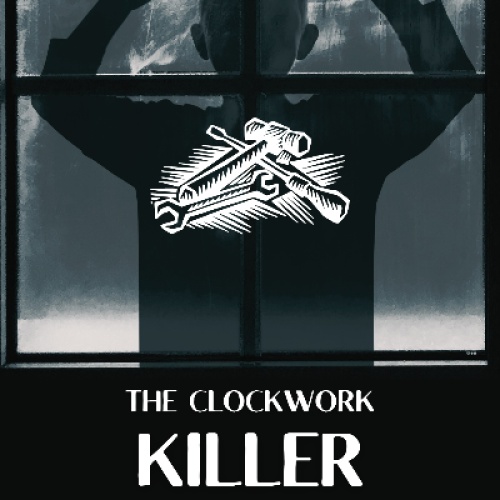Once a soothing rhythm, the ticking of the clock now made Detective Inspector Alistair Croft's back hair stand up. Every second that went by brought him nearer to the revolting truth of the Clockwork Killer, a serial killer whose victims were found with their internal organs precisely removed and arranged with elaborate clockwork machines.
In his studio, the first victima well-known horologist named Elias Thorn had been found with his chest cavity a horrific exhibition of gears, springs, and cogitations. Also at the city ballet studio was the second girl, a ballerina noted for her elegant motions, Lily Carter, her tiny music box that played a haunting tune replacing her heart.
The famous surgeon is third, constitutes Great Alistair Finch was discovered in the hospital operating theater with his brain cavity packed around a sophisticated astrolabe that eerily foretell the victim's time of death.
Though Croft prided himself on his careful investigative technique, he started to feel more uneasy. This was not only a series of ghastly killings; it was a twisted opus, a macabre death dance choreographed by a genius but severely disturbed brain.
"Any leads, Sergeant Davies? " Croft asked wearily.
Young, eager officer Sergeant Davies shook his head. "Nothing absolute, such. We've inspected Thorne's workshop, Carter's studio, and even Finch's hospital. No forced entry, no witnesses, no even one fingerprint. "
Croft sighed, looking at Dr. 's postmortem photos;it's quite aggravating. Finching. This killer is a spirit that slips in and out of shadows but leaves no mark.
The methods of the killer were both disturbing and perplexing. Obviously a talented doctor, he could carry out complex operations free of any evidence being left behind. An artist himself, he painstakingly fashioned the clockwork systems that replaced his victims's organs. Every means served to reflect the morbid life and career of the victims quite clearly.
Croft saw a troubling trend emerging as he dug further into the inquiry. Every victim was a well-known personality in their own areas of talent, people who had attained some degree of celebrity and accomplishment. Was the murderer aiming for their achievements or their societal contributions? Or was it some kind of twisted, personal revenge?
Motivated by a macabre curiosity, Croft chose to tour the clockwork museum of the city. Hours enthralled by the complex artistry of the ancient clocks, he wandered the galleries.
Observing a young man drawing in a close alcove, his face white and drawn, his eyes set on a grandfather clock with sophisticated astronomical engravings was seen by him.
The man was an avid clockwork lover who marveled at the sophisticated systems that powered these timepieces. His words tinged with a odd sadness, he spoke with a restrained energy.
Croft felt like he was speaking with a kindred spirit, someone who grasped the depths of human obsession, as he listened to him.
Ethan seemed, though, perturbed by Croft's presence. With a lingering unease, he fast gathered up his drawings and exited the museum.
Croft opted to investigate Ethan Croft's past back at the police station. He found Ethan to be a loner, a brilliant but disturbed young person with a background of social seclusion. Home schooled, he had been devoting most of his time surrounded by clockwork systems.
As Croft reconstructed Ethan's profile, a horrible realization came to him. Ethan fit the profile of the Clockwork Killer perfectly.
He had the precise talents, the creative gift, and the strong fascination for clockwork systems.
But could Ethan really have committed such heinous crimes? Croft hesitated, dealing with the evidence's weight. Ethan's connection with the killings was not clearly shown; there were only some disturbing coincidences and a developing feeling of unease.
Croft resolved to keep tabs on Ethan's flat driven by a blend of suspicion and a hope for answers. Watching his every move for days, he searched for any sign of guilt.Watching Ethan from Croft's side of the road one evening, Croft saw something really worrying. Ethan was surgically dissecting a small bird with careful and calculated movements. His face bright from the cool light of a surgical light, he started installing a succession of small gears and springs in place of the bird's internal organs.
With the bird's wings fluttering mechanically, its beak opening and closing in a sinister caricature of life, Croft watched in terror as Ethan erected the repugnant device. It was a chilling example of madness as well as creativity.
Believing he had at last discovered his murderer, Croft advanced for the arrest. Ethan, on the other hand, was ready. A lethal labyrinth of clockwork devices created to maim and slay, he had set his flat with several booby traps.
There followed a rigorous battle and lethal dance between the hunter and the prey. Using his years of practice and some fortune, Croft succeeded in disarming Ethan and arresting him.
Ethan's eyes glanced across Croft as he was guided in. His eyes show no sorrow; only a cold feeling of satisfaction as if he had at last finished his great piece.
The subsequent case caught the attention of the media. With his disturbing indifference to human life and his sinister works, the Clockwork Killer seized the imagination of the public. Throughout the hearing, Ethan nevertheless remained silent, rejected to admit his offenses or provide any justification for his behavior.
Ultimately, Ethan was tried and given a life term. At long last, the man who had danced with death and flouted the very fabric of life was brought to justice.
But as Croft observed Ethan being taken away, he couldn't shake the feeling that the darkness still lingering was a cold reminder of the depths of human depravity the killer had taken in. Once a soothing beat, the ticking of the clock now repeated in his head, a chilling reminder of the guy who had transformed time itself into a tool of death.The trial was a circus in media. Live from the courtroom, news channels highlight Ethan Croft, the pale, bony figure with eyes that appeared to contain the secrets of a thousand ticking clocks. Experts argued over the character of his insanity, analyzing his reasons with clinical removal.
Was it a creepy critique of a civilization that prized accomplishment above everything else, a twisted homage to the human body, a macabre effort to achieve immortality by means of mechanical means? An agonizing plea for help from a soul adrift in the maze of its own creation?
Exhausted by the continuous media attention and the emotional impact of the trial, Croft found himself inspired once more to return to the Clockwork Museum. The alcove where he had first met Ethan was revisited by William; the air was heavy with the recollection of the young man's unnerving energy. Now charged with a sinister meaning, he stood in front of the grandfather clock with its delicate astrophysical carvings.
A shivery knowledge descended on him as he studied the sophisticated mechanisms of the clock. The murderer was trying to rise above death and defeat the natural deterioration of the human body; he was not only substituting organs with clockwork. She was hoping to transcend death and beat the unavoidable decay of the human body. In a macabre sense, every victim became a living timepiece, their bodies turned into complex artifacts defying the normal order.
Croft recalled the bird; its artificial motions were a horrible mockery of life. The killer wasn't just a murderer; he was a god manipulating the very stuff of life. He had wanted to replace the random, erratic rhythm of the human heart with the cold, mechanical accuracy of clockwork, therefore to bring organization to the very core of life itself.
The trial brought Ethan to justice but did not answer the more fundamental issues. Was this great mind propelled by desperation to attain immortality, to overcome death itself? Or was it a terrifying statement on a society that esteemed accomplishment above everything else, a society that had neglected to support the delicate human soul?
Haunted by the image of the mechanical movements of the bird, Croft knew that the solutions to these questions would still evade him. With his grisly inventions and his freezing contempt for human life, the Clockwork Killer had left an unforgettable impression on the city, a chilling reminder of the darkness beneath the facade of human civilization.
Once a soothing rhythm, the ticking of the clock now echoed in Croft's mind, a chilling and constant memory of the man who had transformed time itself into a weapon of demise. And he wondered, too, as he stared at the complex mechanisms of the grandfather clock, whether the murderer was still tinkering, still trying to resist the unavoidable, still trying to bend time to his own desire even from within his prison cell.
In his studio, the first victima well-known horologist named Elias Thorn had been found with his chest cavity a horrific exhibition of gears, springs, and cogitations. Also at the city ballet studio was the second girl, a ballerina noted for her elegant motions, Lily Carter, her tiny music box that played a haunting tune replacing her heart.
The famous surgeon is third, constitutes Great Alistair Finch was discovered in the hospital operating theater with his brain cavity packed around a sophisticated astrolabe that eerily foretell the victim's time of death.
Though Croft prided himself on his careful investigative technique, he started to feel more uneasy. This was not only a series of ghastly killings; it was a twisted opus, a macabre death dance choreographed by a genius but severely disturbed brain.
"Any leads, Sergeant Davies? " Croft asked wearily.
Young, eager officer Sergeant Davies shook his head. "Nothing absolute, such. We've inspected Thorne's workshop, Carter's studio, and even Finch's hospital. No forced entry, no witnesses, no even one fingerprint. "
Croft sighed, looking at Dr. 's postmortem photos;it's quite aggravating. Finching. This killer is a spirit that slips in and out of shadows but leaves no mark.
The methods of the killer were both disturbing and perplexing. Obviously a talented doctor, he could carry out complex operations free of any evidence being left behind. An artist himself, he painstakingly fashioned the clockwork systems that replaced his victims's organs. Every means served to reflect the morbid life and career of the victims quite clearly.
Croft saw a troubling trend emerging as he dug further into the inquiry. Every victim was a well-known personality in their own areas of talent, people who had attained some degree of celebrity and accomplishment. Was the murderer aiming for their achievements or their societal contributions? Or was it some kind of twisted, personal revenge?
Motivated by a macabre curiosity, Croft chose to tour the clockwork museum of the city. Hours enthralled by the complex artistry of the ancient clocks, he wandered the galleries.
Observing a young man drawing in a close alcove, his face white and drawn, his eyes set on a grandfather clock with sophisticated astronomical engravings was seen by him.
The man was an avid clockwork lover who marveled at the sophisticated systems that powered these timepieces. His words tinged with a odd sadness, he spoke with a restrained energy.
Croft felt like he was speaking with a kindred spirit, someone who grasped the depths of human obsession, as he listened to him.
Ethan seemed, though, perturbed by Croft's presence. With a lingering unease, he fast gathered up his drawings and exited the museum.
Croft opted to investigate Ethan Croft's past back at the police station. He found Ethan to be a loner, a brilliant but disturbed young person with a background of social seclusion. Home schooled, he had been devoting most of his time surrounded by clockwork systems.
As Croft reconstructed Ethan's profile, a horrible realization came to him. Ethan fit the profile of the Clockwork Killer perfectly.
He had the precise talents, the creative gift, and the strong fascination for clockwork systems.
But could Ethan really have committed such heinous crimes? Croft hesitated, dealing with the evidence's weight. Ethan's connection with the killings was not clearly shown; there were only some disturbing coincidences and a developing feeling of unease.
Croft resolved to keep tabs on Ethan's flat driven by a blend of suspicion and a hope for answers. Watching his every move for days, he searched for any sign of guilt.Watching Ethan from Croft's side of the road one evening, Croft saw something really worrying. Ethan was surgically dissecting a small bird with careful and calculated movements. His face bright from the cool light of a surgical light, he started installing a succession of small gears and springs in place of the bird's internal organs.
With the bird's wings fluttering mechanically, its beak opening and closing in a sinister caricature of life, Croft watched in terror as Ethan erected the repugnant device. It was a chilling example of madness as well as creativity.
Believing he had at last discovered his murderer, Croft advanced for the arrest. Ethan, on the other hand, was ready. A lethal labyrinth of clockwork devices created to maim and slay, he had set his flat with several booby traps.
There followed a rigorous battle and lethal dance between the hunter and the prey. Using his years of practice and some fortune, Croft succeeded in disarming Ethan and arresting him.
Ethan's eyes glanced across Croft as he was guided in. His eyes show no sorrow; only a cold feeling of satisfaction as if he had at last finished his great piece.
The subsequent case caught the attention of the media. With his disturbing indifference to human life and his sinister works, the Clockwork Killer seized the imagination of the public. Throughout the hearing, Ethan nevertheless remained silent, rejected to admit his offenses or provide any justification for his behavior.
Ultimately, Ethan was tried and given a life term. At long last, the man who had danced with death and flouted the very fabric of life was brought to justice.
But as Croft observed Ethan being taken away, he couldn't shake the feeling that the darkness still lingering was a cold reminder of the depths of human depravity the killer had taken in. Once a soothing beat, the ticking of the clock now repeated in his head, a chilling reminder of the guy who had transformed time itself into a tool of death.The trial was a circus in media. Live from the courtroom, news channels highlight Ethan Croft, the pale, bony figure with eyes that appeared to contain the secrets of a thousand ticking clocks. Experts argued over the character of his insanity, analyzing his reasons with clinical removal.
Was it a creepy critique of a civilization that prized accomplishment above everything else, a twisted homage to the human body, a macabre effort to achieve immortality by means of mechanical means? An agonizing plea for help from a soul adrift in the maze of its own creation?
Exhausted by the continuous media attention and the emotional impact of the trial, Croft found himself inspired once more to return to the Clockwork Museum. The alcove where he had first met Ethan was revisited by William; the air was heavy with the recollection of the young man's unnerving energy. Now charged with a sinister meaning, he stood in front of the grandfather clock with its delicate astrophysical carvings.
A shivery knowledge descended on him as he studied the sophisticated mechanisms of the clock. The murderer was trying to rise above death and defeat the natural deterioration of the human body; he was not only substituting organs with clockwork. She was hoping to transcend death and beat the unavoidable decay of the human body. In a macabre sense, every victim became a living timepiece, their bodies turned into complex artifacts defying the normal order.
Croft recalled the bird; its artificial motions were a horrible mockery of life. The killer wasn't just a murderer; he was a god manipulating the very stuff of life. He had wanted to replace the random, erratic rhythm of the human heart with the cold, mechanical accuracy of clockwork, therefore to bring organization to the very core of life itself.
The trial brought Ethan to justice but did not answer the more fundamental issues. Was this great mind propelled by desperation to attain immortality, to overcome death itself? Or was it a terrifying statement on a society that esteemed accomplishment above everything else, a society that had neglected to support the delicate human soul?
Haunted by the image of the mechanical movements of the bird, Croft knew that the solutions to these questions would still evade him. With his grisly inventions and his freezing contempt for human life, the Clockwork Killer had left an unforgettable impression on the city, a chilling reminder of the darkness beneath the facade of human civilization.
Once a soothing rhythm, the ticking of the clock now echoed in Croft's mind, a chilling and constant memory of the man who had transformed time itself into a weapon of demise. And he wondered, too, as he stared at the complex mechanisms of the grandfather clock, whether the murderer was still tinkering, still trying to resist the unavoidable, still trying to bend time to his own desire even from within his prison cell.





